2014 安徽省中小学新任教师招聘考试小学英语真题及答案
Ⅰ.单项选择(共 10 题,每小题 1 分,共 10 分)
从每小题所给的 A、B、C、D 四个选项中选出一个能填入空白处的最合适的选项,并将
该选项的序号填入相应的方框内。
1. We now face an embarrassing ________: should we stay or go?
A. circumstance
C. enquiry
2. ________ a child and you will find that he is happy every day in whatever
B. expectation
D. dilemma
he does.
A. Observe
B. To observe
C. Observed
D. Observing
3. Bob’s very ________. He does all the odd jobs around the house.
A. practical
C. cautious
4. This is a binding contract. ________, we recommended that you review it with
D. careless
B. clever
a lawyer.
A. Furthermore
B. Meanwhile
C. Therefore
D. Nevertheless
5. We thought that ________ we were in the area, we’d stop by and visit them.
A. where
C. unless
6. —Jenny took the 8:00 bus to Beijing this morning.
—Really?She ________ the 9:00 train. It’s more comfortable and safer to travel
D. until
B. since
by train.
A. could take
B. must take
C. could have taken
D. must have taken
7. It has long been recognized that cultural variables influence the way children
understand the world, present themselves, and ________ experiences.
A. interpret
C. create
8. Every culture has its own body language, and one absorbs its meaning along
B. reproduce
D. explain
with
languages.
A. literal
C. signal
9. Being a boy’s book specially written for adults, ________ is Mark Twain’s
D. spoken
B. hang
�
most representative work, describing a journey down the Mississippi undertaken by
Huck and Jim.
A. Innocent Abroad
B. Adventures of Huckleberry Finn
C. Life on the Mississippi
D. The Gilded Age
10. “If winter comes, can spring be far behind?” is an epigrammatic line by
________.
B. W. Wordsworth
A. J. Keats
C. W. Blake
Ⅱ. 完形填空(共 20 题,每小题 1 分,共 20 分)
从每小题所给的 A、B、C、D 四个选项中选出一个能填入空白处的最合适的选项,并将
D. P. B. Shelley
该选项的序号填入相应的方框内。
16
17
15
12
11
can help them acquire good pronunciation and intonation,
Reading aloud and silent reading are two different types of reading practice.
by the other.
Each has a function in the teaching of reading and should not be
However, we need to be aware when we should use them. When we
teaching reading
or developing reading skills, we are mostly referring to silent reading. To develop
13
readers in a foreign language, silent reading activities must be given enough
14
. Reading aloud also
and time in class with the proper guidance from the
for our students who are learning English as a foreign
has its particular
language.
18
their confidence
them with new words and the stress patterns of English, help
for students
in speaking the language. Therefore, opportunities should be
to read aloud only after they have comprehended the text
before comprehension
and it can easily destory their self-confidence.
comprehension can be very
reading, it sets up a poor reading model for other students as well.
With
It is
reading
activities and then with comprehension we give our students practice by using an
a good model for practicing reading aloud. With adequate
audio tape to
27
their
motivation and confidence. By asking the students to read aloud, it is also a good
chance for the teacher to get
on the students’ comprehension as we can notice
30
there are wrong pauses or mispronounced words which indicate possible
difficulties or misunderstanding of the text.
, we may ask the students to read aloud to the whole class to
24
that we first help students learn the text through
25
19
20
21
22
29
23
26
28
11. A. described
C. explained
12. A. work out
C. talk about
13. A. proficient
B. provided
D. replaced
B. run into
D. take on
B. enjoyable
�
D. They
B. supply
D. straightforward
B. attention
D. wipe out
B. particular
D. dependable
D. familiarize
B. build up
D. burden
B. teacher
D. actor
B. as well as
D. better than
B. systematic
B. conclusion
D. frustration
B. One
C. considerate
14. A. money
C. sacrifice
15. A. colleague
C. headmaster
16. A. quality
C. value
17. A. It
C. We
18. A. involve
C. charge
19. A. go through
C. show off
20. A. available
C. attractive
21. A. apart from
C. instead of
22. A. impressive
C. dominant
23. A. complete
C. careful
24. A. better
C. negative
25. A. simplified
C. silent
26. A. celebrate
C. depress
27. A. practice
C. knowledge
28. A. respect
C. boost
29. A. suggestion
C. promotion
30. A. where
C. how
Ⅲ.阅读理解(共 12 题,每小题 2 分,共 24 分)
阅读下列短文,从每小题所给的 A、B、C、D 四个选项中选出一个能填入空白处的最佳
D. difficult
B. broken
D. disgusting
D. amount
B. check
D. desert
B. feedback
D. inspiration
D. desperate
B. represent
B. worse
D. unfair
B. overwhelming
D. provide
B. material
B. why
D. whether
选项,并将该选项的序号填入相应的方框内。
A
Primary education is compulsory in Britain. It begins at five in Great Britain
and four in Northern Ireland. All children have to attend primary school and they
�
finish their primary education at the age of 11. In addition to the many state primary
schools which don’t ask their pupils to pay fees, there are also some fee-paying
independent primary schools. The most famous fee-paying primary schools are the
preparatory schools which admit children from 7 to 13 years old.
Primary schools are almost mixed sex and usually located close to the child’s
home. Children tend to be with the same group throughout the day and one teacher
has responsibility for most of the work they do. But parents are strongly encouraged
to help their children, particularly with reading and writing, and small amounts
of homework are set to all children after school.
Scotland has its own qualification framework that is separate from that in
England, Wales and Northern Ireland. After seven years of primary education and four
years of compulsory secondary education, students aged 15 to 16 may take the Scottish
Certificate of Education. The Scottish Certificate of Education is recognized
throughout the UK as the equivalent to A-levels and is usually the entry
qualification for university.
British universities are funded directly by central government grants. They
enjoy complete academic freedom, appoint their own staff, decide which students to
admit, provide their own courses and award their own degree. Admission is by
selection on the basis of A-level results, school references and an interview. Higher
education in Britain is not compulsory and students would have to pay fees, but the
government would give students financial help if they need the help. There are some
90 universities, including the Open University in Britain. The most famous ones are
Oxford and Cambridge. There is also the Open University which is “open” to all
that want to continue to study, mainly adult students.
B. 13
D. 16
.
B. a comment
D. an explanation
31. The first paragraph’s function is ________.
A. a review
C. an introduction
32. Students are expected to complete primary education at the age of ________.
A. 11
C. 15
33. Which of following is TRUE?
A. It is easier for Scottish students to enter university without A-levels.
B. Central government offers fund to British universities directly.
C. Scottish Certificate of Education is partially recognized in the UK.
D. Scotland has the same qualification framework as other parts of UK have.
34. We can learn from the last paragraph that
A. students with financial problem are rejected by universities
B. Open University is available to everyone except adult students
C. British universities have all the rights on academic affairs
D. British government determines the appointment of university staff
B
The authors of the study, released Thursday on the seventh anniversary of the
Sept. 11 attacks, said that despite years of government efforts to enhance disaster
preparedness, schools need to do more to plan for disasters and parents need to be
�
made aware of the plans. Among parents of school-age children, 45 percent said they
do not know the location where their children would be evacuated as part of the
school’s disaster plan. “There should be an outcry from parents to push their
schools and their school districts to develop a plan that makes sense.” said Irwin
Redlener, president of the children’s health fund.
The federal department of homeland security has allocated billions of dollars
to help state and local government set up disaster contingency plans, but just 44%
of the U.S. residents surveyed this year said they have all or some of the basic
elements of a disaster preparedness plan, including food, water, a flashlight with
extra batteries and a meeting place in case of evacuation.
Parents said Thursday they were not surprised by the finding that most of them
would disregard evacuation orders and pick up their children. Diana Enen, a mother
of three said, “As a mom, you wouldn’t be able to keep me away from picking up
my children. My first instinct would be to get them at all costs. I would literally
run the entire distance to get them. I believe most parent would feel the same.”
35. What would most U.S. parents do in a disaster?
A. They ignored orders to reunite with their children.
B. They would try all they can to hinder the traffic.
C. They would like to help police deal with traffic congestion.
D. They blamed school for the terrible disaster preparedness pan.
36. We can learn from the second paragraph that ________.
A. parents care little about the disaster plan
B. there is an outcry to enlarge school districts
C. schools should do more in the disaster preparedness
D. places for children to evacuate are known to all parents
37. According to the text, ________ of the school-age children’s parents are
not sure where their children will be evacuated in a disaster.
B. 45%
D. 66%
A. 44%
C. 63%
38. It can be inferred from the text that ________.
A. reasonable plans for disasters should be developed
B. U.S. government has been well prepared for disasters
C. parents are expected to take children home in a disaster
D. U.S. schools and government protect children at all costs
C
Everyone agrees that innovation is the key to solving the many challenges we
face as a country from health care to education to the environment, and is fundamental
to restoring economic growth and prosperity. But I would put it a slightly different
way. We must find a way to rebuild the “innovation infrastructure” in this county.
The problem is not that Americans aren’t as inherently innovative as ever we
are.
of
innovation—determining the best recipes to make it happen—has been skyrocketing
over the past few years. For example, the number of times the word “innovation”
appeared in Google news stores has increased by approximately five from Obama’s
Americans
in
the
of
interest
process
And
the
level
among
�
Google the term “innovation” and you’ll get 342 million
inauguration to today.
hits, approximately half the 676 million hits that “Obama” generates. And
according to hash tags org, innovation is trending about the same rate as deficit.
Our problem is that the system is failing our citizens. The “seed corn” of
innovation-creative ideas ... fundamental rate it was before. Viable“seed corn”
requires an innovation infrastructure in which bright minds are provided the
resources and freedom to create and invent according to their passions and
curiosities, to take bold risks, and even to fail. Such an innovation infrastructure
thrived in the U.S. in the late 20th century as a collaboration that put Americans
on the moon, and to the personal computer, the Internet, and the era of genomic
medicine.
Americans are ready and willing to embrace the goal of once again leading the
world in innovation. This could be the moon shot for the next decade that unifies
our country. However, we are at a tremendous disadvantage unless the innovation
infrastructure of this country is rebuilt. This requires a new collaboration among
government, industry and academia-one that is suited to the challenges and
opportunities of the digital age, and that restores the bold risk taking and action
orientation of earlier times.
39. According to the author, innovation in American has ________.
A. gone completely lost nowadays
B. been weakened gradually
D. been taken back in Obama’s day
D. come to a turning point
40. What can we get from hash tags org’s findings?
A. Innovation will finally drag the development of economy.
B. People show the same concern in innovation as that in deficit.
C. Innovation can arouse more interest in people than Obama can.
D. Obama has to focus on rebuilding Americans tradition in innovation.
41. Today’s structures of innovation need to be rebuilt because ________.
A. Americans have lost interest in innovation during the past years
B. too many risky ideas have destroyed people’s confidence in innovation
C. institutions, government and business cannot cooperate effectively as before
D. the essential elements of innovation have lost its energy for development
42. The main content of the text can be summarized as ________.
A. The main problem about innovation and the solution
B. The optimistic aspects of the development of innovation
C. The analysis of the advantages and disadvantages of innovation
D. The pessimistic prediction of the development of innovation
Ⅳ.翻译(共 5 题,每小题 2 分,共 10 分)
将下列短文中划线的句子翻译成中文。
The use of laughter therapy has been in hospitals since the 1970s.(43)A doctor
in the U.S. found that getting his patients to laugh helped them recover better.
His story was later made into the movie Patch Adams which starred Robin Williams.
(44)In India, Dr. Kadan Kataria started a laughter club in 1995 to encourage good
�
health. From then on, this form therapy has spread around the world.(45)People
in these groups may feel uncomfortable at first because the laughter feels forced.
(46)But once they give in and fully enjoy the 45-minute activity, they feel at
ease.(47)People who take part in laughter therapy learn what scientists have known
for years—laughter is the best medicine.
Ⅴ.书面表达(20 分)
学习在教师专业发展中起着重要作用,请你以“The Importance of the Life-Long
Learning to a Teacher”为题,谈谈自己的体会和看法。
注意:词数不少于 150。
Ⅵ. 教学设计(20 分)
根据下面提供的教学材料,用英文简述教学目标、教学重难点、词汇教学的主要步骤及
其设计意图(设计意图可用中文表达)。
farmer
nurse
cook driver
doctor
一个小孩子说: “What’s your father’s job?”
另一个小孩子说: “My father’s job is a doctor.”
Ⅶ. 教学案例分析(16 分)
下面是一篇小学对话教学的教学材料及其教学过程设计。请用中文从教师角色、活动设
计等方面进行简要评述。
教学内容:
John: Mum, I have a new friend.
Mum: Really? A Chinese friend?
John: Yes, he’s very friendly.
Mum: What’s his name?
John: His name is Zhang Peng. Look! He’s tall and strong.
Mum: Yes, he is.
教学过程:
1.教师展示课文图片并提问:How many people do you see in the picture?Who are they?
What are they talking about?
2.播放对话视频,让学生回答一个简单的问题:What’s John’s friend’s name?
3.再次观看对话,让学生获取更多关于 Zhang Peng 的信息,完成图表。
4.用“爸爸去哪儿”电视节目里的人物呈现多张图片,帮助学生在语境中理解 friendly
和 quiet 的含义,再请同学用这两个词说一说班里同学。
5.学生根据图表中关键词复述 Zhang Peng 的信息:Zhang Peng is a Chinese boy. He’
s strong. He’s friendly.
6.听录音,学生进行 pair work,分角色朗读对话。
7.谈论喜爱的电视节目人物。根据 PPT 呈现的节目中五个孩子形象,教师先示范描述:
I like Kimi best. He’s short and thin. He’s friendly.学生描述喜欢的人物,鼓励
学生用更多的词汇表达,并把印有节目中五个孩子的小卡片作为奖励。
8.谈论自己的同学或朋友:运用本节课所学内容先在小组讨论,再上讲台展示。
参考答案
1-10 DAACB
CAABD
�
11-20
21-30
31-40
41-42
DCABB
CDBAC
CABCA
DA
CADBA
DACBD
CBADB
�
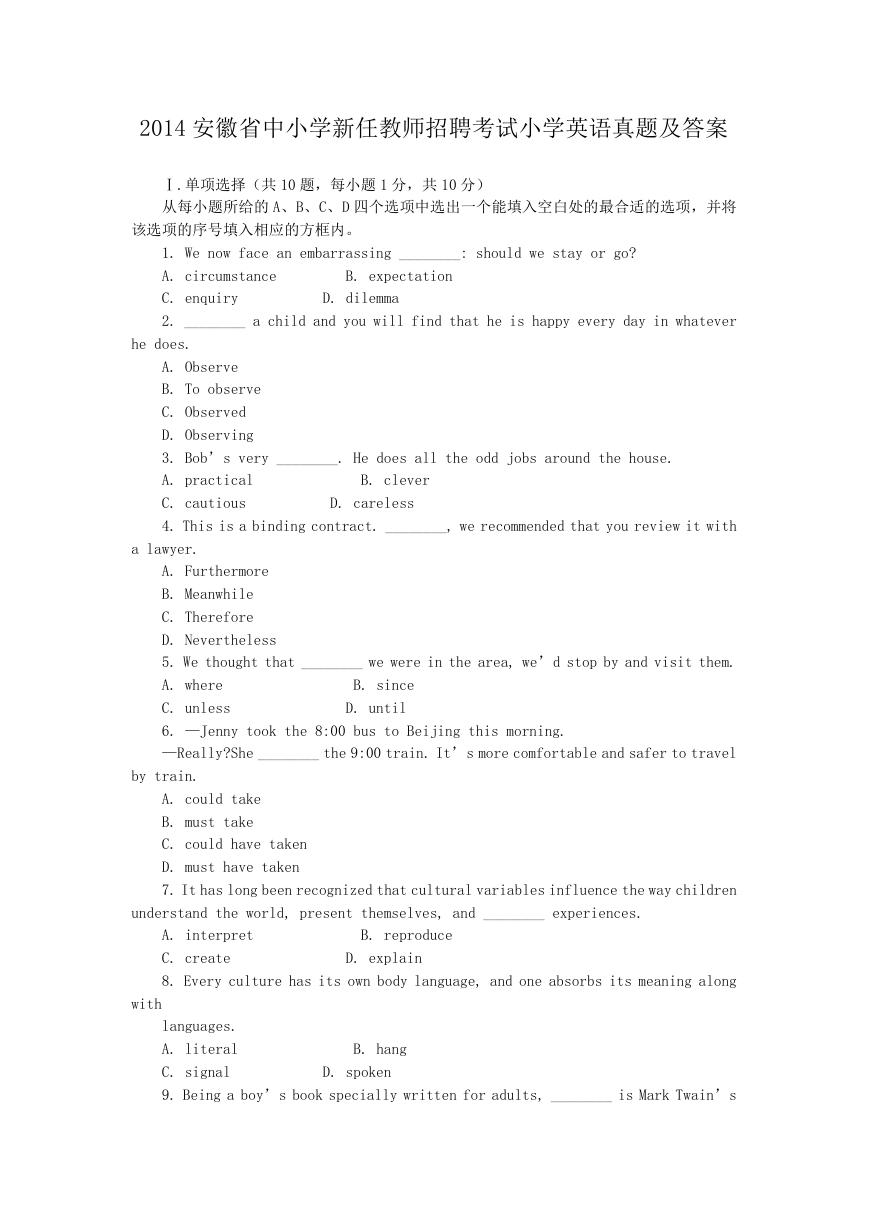
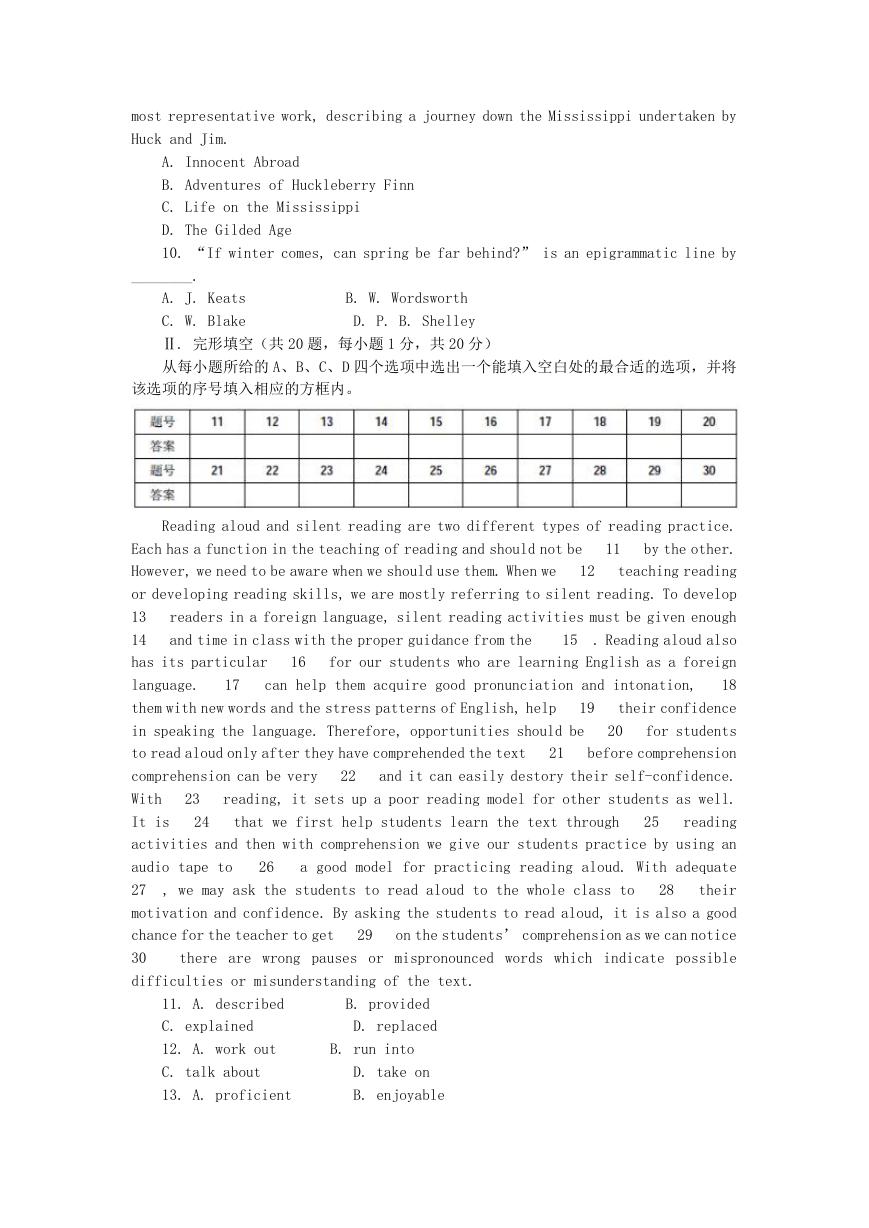
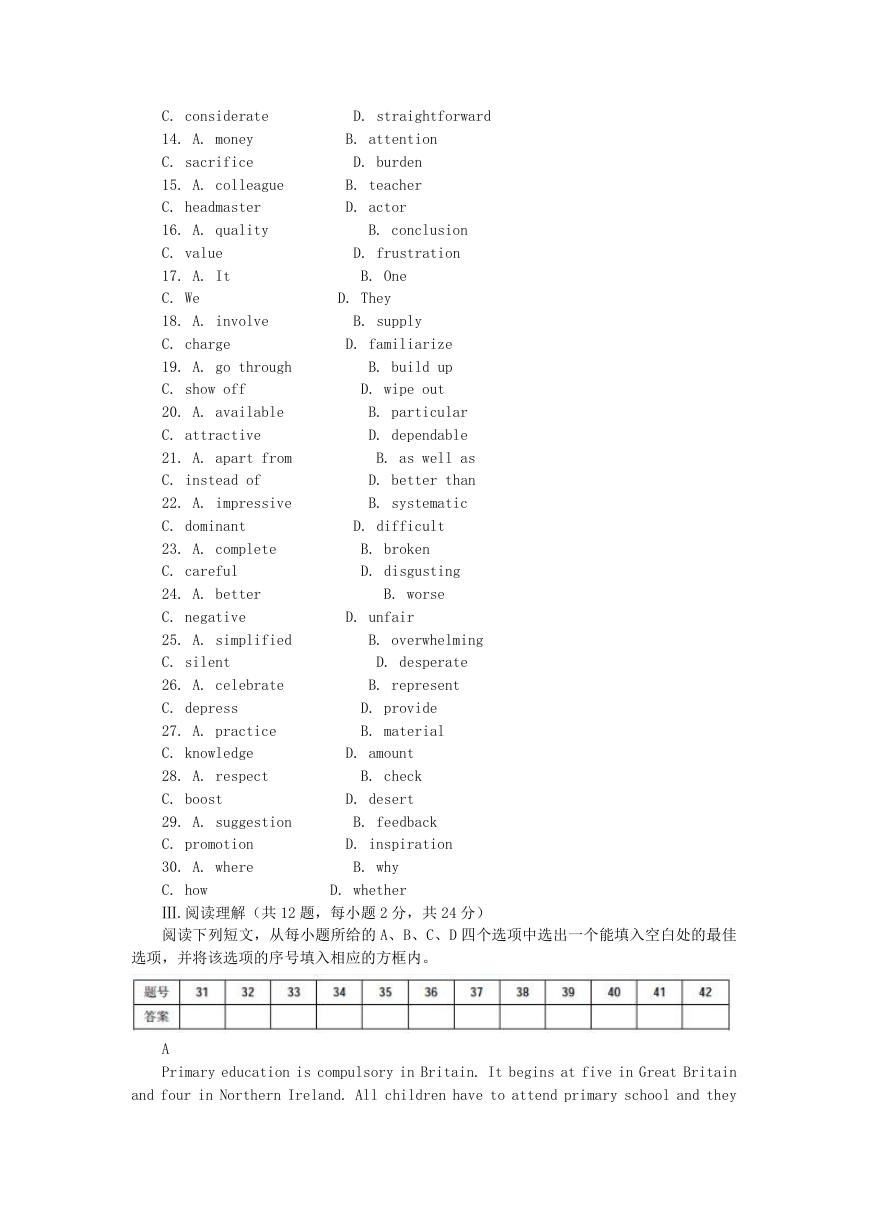
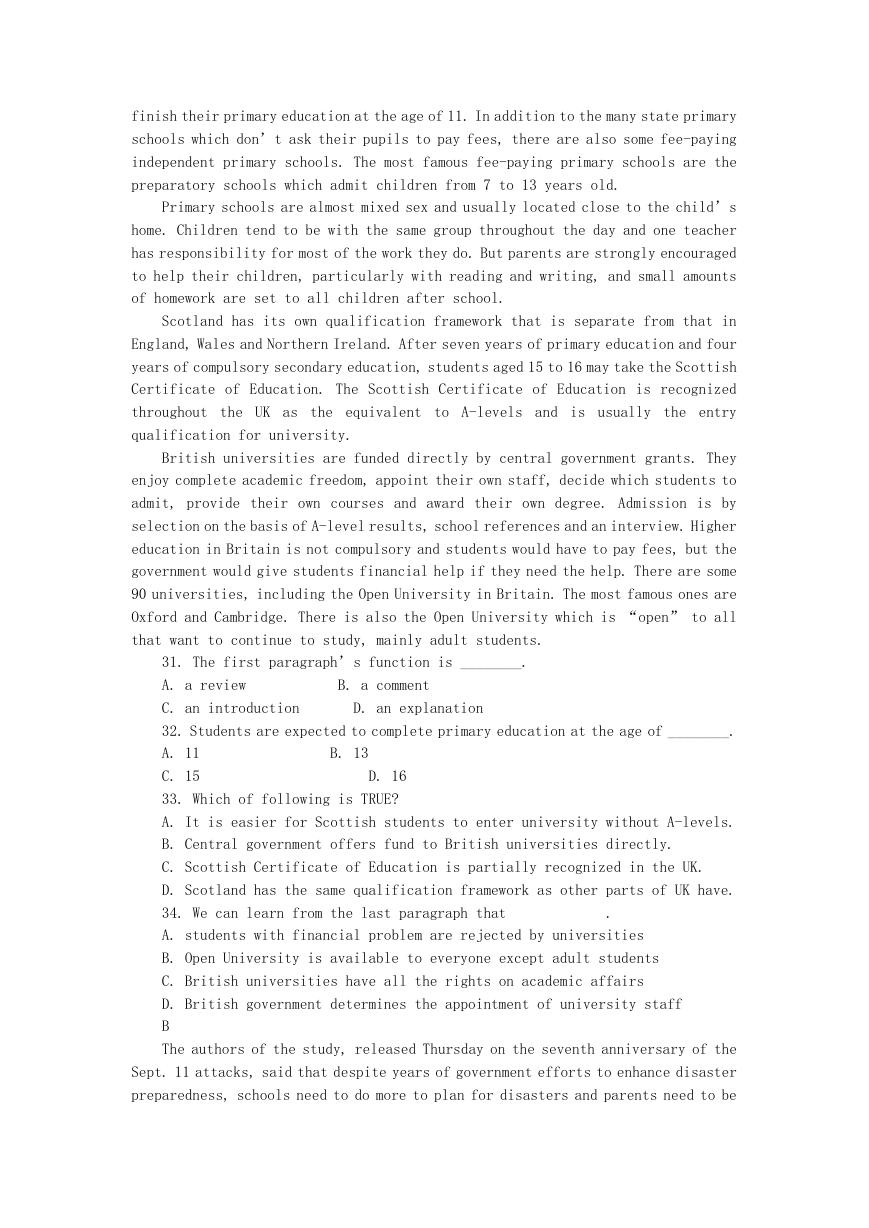

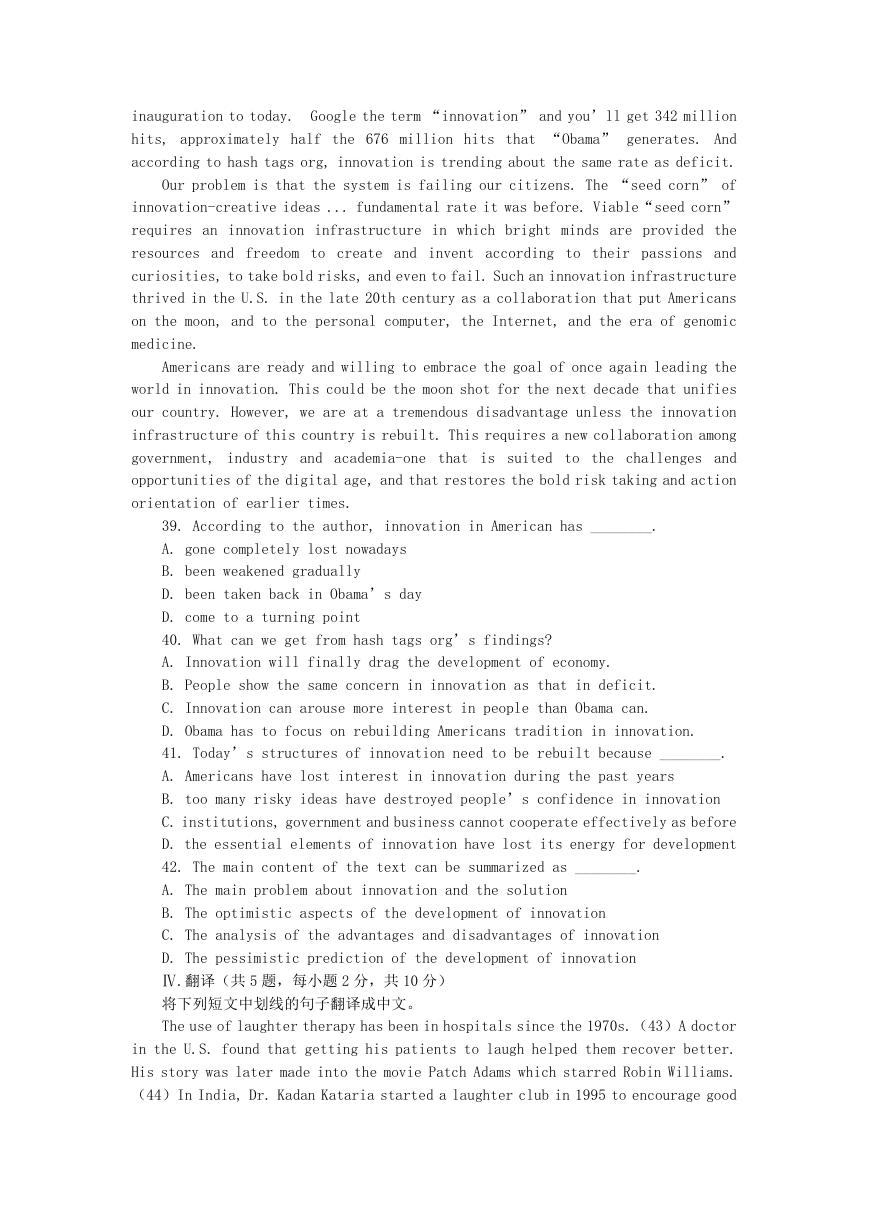

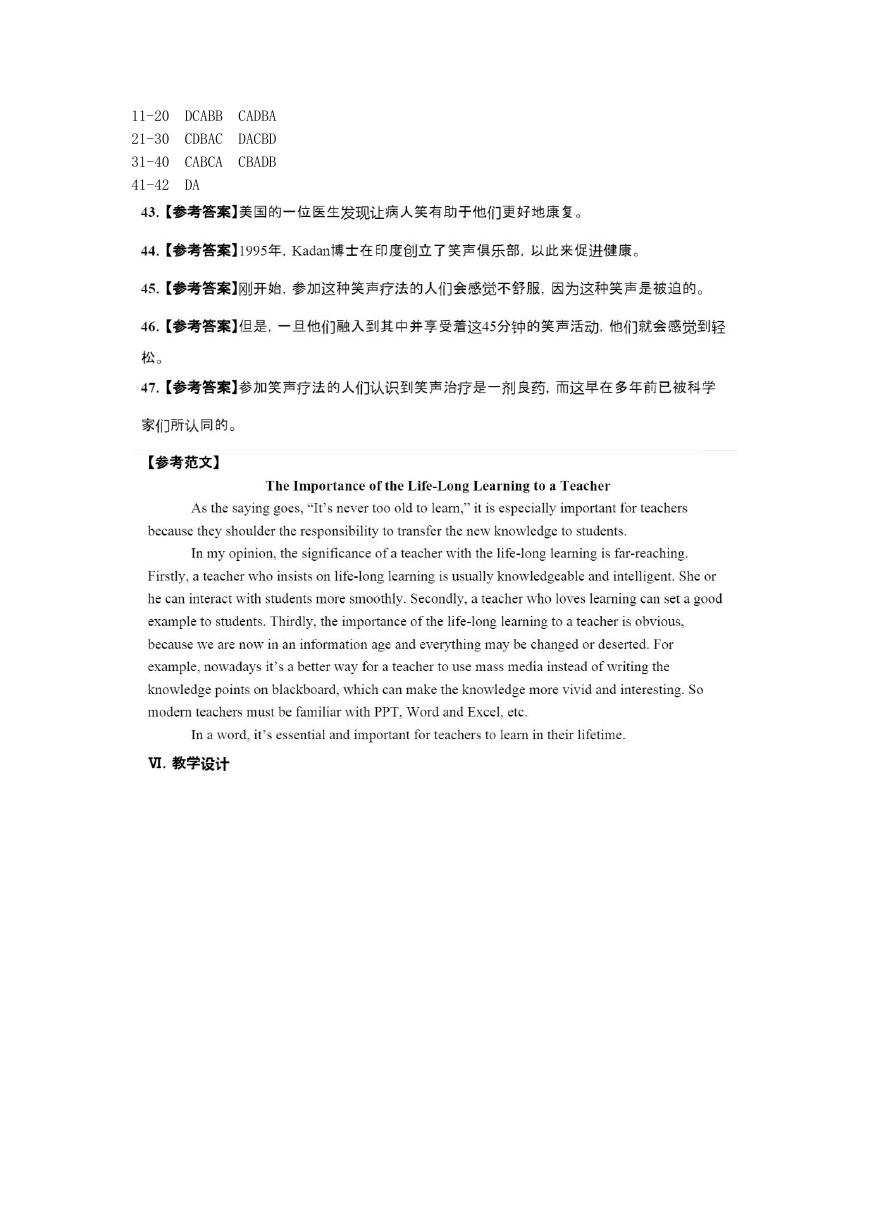








 2023年江西萍乡中考道德与法治真题及答案.doc
2023年江西萍乡中考道德与法治真题及答案.doc 2012年重庆南川中考生物真题及答案.doc
2012年重庆南川中考生物真题及答案.doc 2013年江西师范大学地理学综合及文艺理论基础考研真题.doc
2013年江西师范大学地理学综合及文艺理论基础考研真题.doc 2020年四川甘孜小升初语文真题及答案I卷.doc
2020年四川甘孜小升初语文真题及答案I卷.doc 2020年注册岩土工程师专业基础考试真题及答案.doc
2020年注册岩土工程师专业基础考试真题及答案.doc 2023-2024学年福建省厦门市九年级上学期数学月考试题及答案.doc
2023-2024学年福建省厦门市九年级上学期数学月考试题及答案.doc 2021-2022学年辽宁省沈阳市大东区九年级上学期语文期末试题及答案.doc
2021-2022学年辽宁省沈阳市大东区九年级上学期语文期末试题及答案.doc 2022-2023学年北京东城区初三第一学期物理期末试卷及答案.doc
2022-2023学年北京东城区初三第一学期物理期末试卷及答案.doc 2018上半年江西教师资格初中地理学科知识与教学能力真题及答案.doc
2018上半年江西教师资格初中地理学科知识与教学能力真题及答案.doc 2012年河北国家公务员申论考试真题及答案-省级.doc
2012年河北国家公务员申论考试真题及答案-省级.doc 2020-2021学年江苏省扬州市江都区邵樊片九年级上学期数学第一次质量检测试题及答案.doc
2020-2021学年江苏省扬州市江都区邵樊片九年级上学期数学第一次质量检测试题及答案.doc 2022下半年黑龙江教师资格证中学综合素质真题及答案.doc
2022下半年黑龙江教师资格证中学综合素质真题及答案.doc